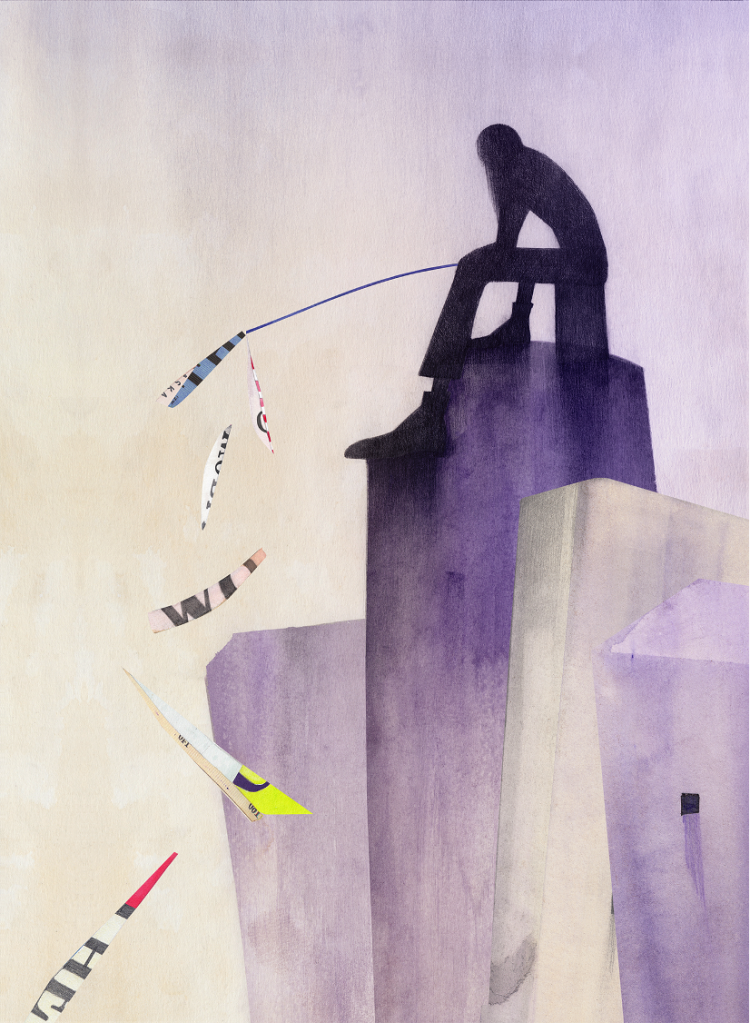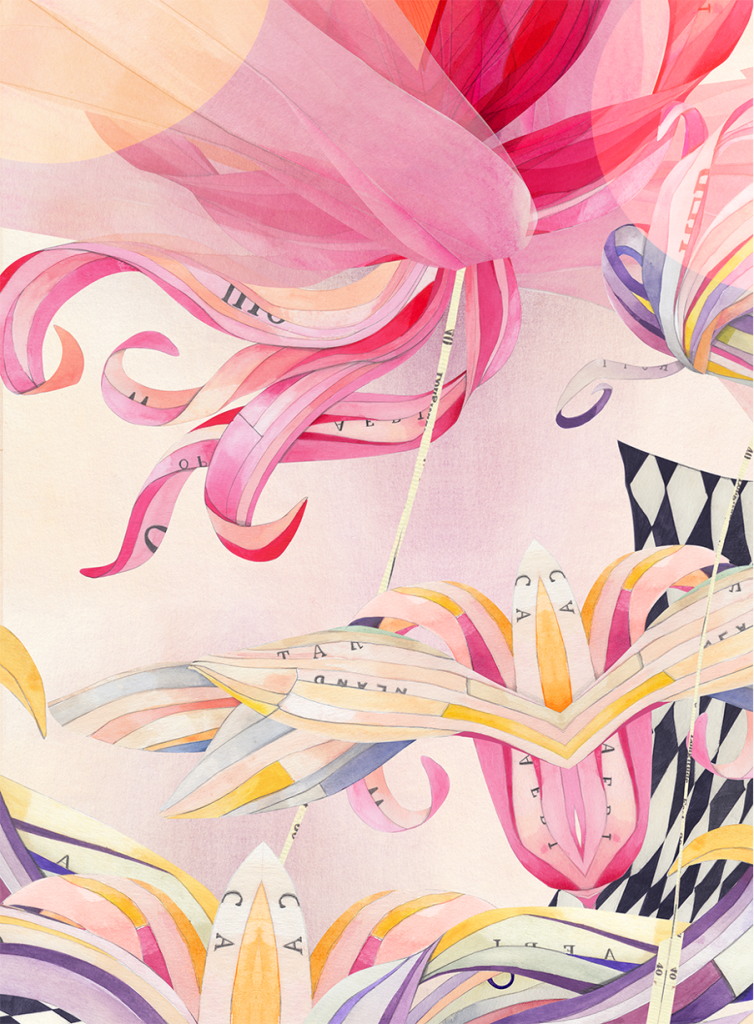
Paper-flower Girl written by Margrete Lamond, illustrated by Mateja Jager
Published by Dirt Lane Press, WestWords
Inside the CBCA Shortlist
Inside the 2024 CBCA Shortlist
Paper-flower Girl is shortlisted in the CBCA 2024 Picture Book of the Year category.
“Up there the Paper-flower Girl.
She speeds. She cuts. She trims.
Petals of purple. Filaments of pale.
Stems of in-between.
‘Too fancy!’ roars the Giant.”
(Paper-flower Girl)
Illustrator Interview: Mateja Jager
Mateja, you and Margrete have created an exquisite picture book in Paper-flower Girl. Congratulations on your well-deserved 2024 CBCA shortlisting and thank you for speaking to Joy in Books at PaperbarkWords.
You are a Slovenian-born Australian illustrator. Where are you based now and how do you allocate your time?
I come from Ljubljana. However, for the past 7 years, I have lived in Sydney, where we moved for my partner’s work. Since being here, I have been working on my creative projects with a main focus on illustration.
Besides that, I love exploring Sydney and even after all these years, I often feel like I am still a tourist because there is so much to discover.
When you first heard the evocative title, Paper-flower Girl, what was your immediate vision for the book? How did this change as your illustrations unfolded?
After reading Margrete’s beautiful story, first of all, I couldn’t believe that she chose me to illustrate it.
My first thoughts were, how to create large, colourful flowers. I knew they had to be distinctive, but I wasn’t sure how to approach them at first. Reflecting on how my background influenced my art, I realised that I may have approached the flowers as if they were a textile pattern.
Margrete’s poetic, sensory words describing the Paper-flower Girl’s interlacing, folding and unfurling of paper to create flowers suggest, and even name, colours.
“Petals of ivory, petals of rust,
Of blood, of blush, of teal.
Filaments of honey and gold.
Tendrils of sage.”
(Paper-flower Girl)
How closely or literally (or not) did you follow her colour descriptions here or elsewhere in the book?
I read the story several times and I absolutely loved Margrete’s writing. It took me a while to draw the flowers that I was happy with because I didn’t want them to be too literal, but rather very original. As for the colours, I followed the main description and the feeling, but not every exact word. I saw the flowers as an extension of the girl, so they reflect her emotional journey throughout the book.
When the giant starts making unrealistic demands, the colours in the girl’s world start fading away. Her flowers droop and become stiff, only blossoming again at the end when she is free and back in her happy place.

This illustration is a great example of flowers and girl sharing the same feelings.
Where, and how, have you used brightness to best effect?
After the giant blindfolds her and she no longer creates the flowers.
Her creations now reflect Giant’s demands, resembling “fireworks” with lots of shine but not much substance.
“Up there the Paper-flower girl
Makes them bright
Makes them loud.
Until even she can see them.”
(Paper-flower Girl)
Which of your illustrations do you feel best captures the ephemeral beauty of paper flowers, and how?
Maybe at the end, there is a giant sitting on his towers. I wanted to portray his insignificance and make him look sad and pathetic as he didn’t get what he wanted. After all he has demanded, he is left with nothing but drooping flowers that he didn’t like anyway.

How have you portrayed the Paper-flower Girl as the antithesis of the Giant?
They are coming from two completely different worlds. I tried to portray this through colour, shape, and size.
When their worlds are first introduced, hers is welcoming, colourful, and soft, which contrasts with the giant on his gloomy, sad, and blue hill.
At the beginning, the giant is big and intimidating, but by the end, the drawings of him are small to portray his insignificance as he didn’t get what he wanted. The illustrations of the girl, on the other hand, grow in size as she grows emotionally until, in the last illustration, she is surrounded by colourful flowers that are embellished by the giant’s scarf.
What is the significance of the Giant’s scarf, its pattern and transformation? Are you able to technically explain how you have melded the seemingly different colours and patterns of the scarf into a beautiful accord with the paper-flowers?
The pattern on the scarf didn’t hold any special significance. Some people wondered if it was related to the current political environment, but the scarf was actually created before the war in Palestine.
After being blindfolded and forced to create “no longer flowers,” she took the scarf home with her. Upon returning, she considered incorporating the scarf into her flower creations. The girl saw the scarf as a gift that helped her create the most beautiful flowers so far.
When I was drawing the last flowers I thought about Mary Oliver’s Poem, “The Uses of Sorrow’.
“Someone I loved once gave me
a box full of darkness.
It took me years to understand
that this, too, was a gift.”

Technically It is a collage of all the flowers and the scarf joined together.
You have used mixed media in the book: pencil, watercolour and collage, and finished digitally in Photoshop. Some of the collage shows letters. They seem to match some of the written text font in the book. Are they from a published written work or somewhere else? What do they represent?
My illustrations are hand-drawn with a pencil, then coloured with watercolour on paper that I distress with a wash of coffee. In this instance, most of the flowers were drawn separately and then added digitally in Photoshop.
As I envisioned creating unique paper flowers, I imagined a girl cutting ribbons from various papers and combining them to make distinct flowers. This is how I would approach making a 3D flower. Therefore, I cut out flowers from my paper drawings just like she might and included them in the illustrations. The letters on many of the flowers were cut out from a world map, symbolising her emotional journey throughout the story.
What do you hope readers most remember and take with them from this book?
I think that it is important to remember that you can’t force anything.
True creativity shines through when it comes from the heart.
What impact has Paper-flower Girl being recognised as a CBCA Shortlisted Picture Book of the Year had on you or this book?
I have signed another book with Dirt Lane Press/WestWords that will be published next year, and I am extremely excited about it.
What are you writing, illustrating or working on now or next?
I’m currently illustrating two books. One of them is with Dirt Lane Press / WestWords and the other one with a publisher from the USA.
What have you been reading that you would like to recommend?

Two books I liked the most this year are :
“Beauty” by Sagmeister & Walsh, which explores the impact of beauty on our lives.
“The Balcony Over Jerusalem” by John Lyons, which helped me to understand the situation in the Middle East a little bit more.
And my favourite book that I frequently revisit and would recommend to anyone is a collection of poems, “Wild Geese” by Mary Oliver.
How can your readers contact you?
The best way to contact me is probably through Instagram – @pinketycards,
or you can visit my website at www.pinkety.com

One thought on “Paper-flower Girl written by Margrete Lamond, illustrated by Mateja Jager”